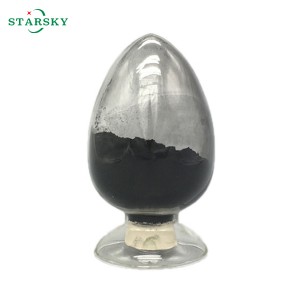-

Cobalt nitrate /Cobaltous nitrate hexahydrate/cas 10141-05-6/ CAS 10026-22-9
Cobalt nitrate , the chemical formula is Co(NO₃)₂, which usually exists in the form of hexahydrate, Co(NO₃)₂·6H₂O. also call Cobaltous nitrate hexahydrate CAS 10026-22-9.
Cobalt nitrate hexahydrate is mainly used in the production of catalysts, invisible inks, cobalt pigments, ceramics, sodium cobalt nitrate, etc. It is also used as an antidote for cyanide poisoning and as a paint desiccant.
-

Boron oxide CAS 1303-86-2
Boric oxide, commonly known as boron trioxide (B2O3), usually occurs as a white glassy solid or powder. It can also occur in crystalline form. When in powder form, it may appear as a fine white or off-white powder. Boric oxide is hygroscopic, meaning it can absorb moisture from the air, which may affect its appearance if it does. In its glassy form, it can be transparent or translucent.
Boric oxide (B2O3) is generally considered insoluble in water. However, under certain conditions, it can react with water to form boric acid (H3BO3).
-

Nickel CAS 7440-02-0 factory price
Manufacture supplier Nickel cas 7440-02-0
-

Silver carbonate CAS 534-16-7
Silver carbonate precipitates as a tender yellow powder and darkens in color under light after drying.
Silver carbonate CAS 534-16-7 can be used to manufacture photosensitive materials such as film, color photographic emulsions, and photo films. It is also used for silver plating, manufacturing conductive adhesives, silver zinc batteries, other silver salts and catalysts, as a sterilizing agent in medicine, and for ceramics.
-

Zirconyl chloride octahydrate CAS 13520-92-8 factory price
Manufacture supplier Zirconyl chloride octahydrate CAS 13520-92-8
-

Strontium Iodide CAS 10476-86-5
Strontium iodide is soluble in water, soluble in ethanol, and insoluble in ether.
Strontium iodide is used as a drug and intermediate.
-

Hafnium powder cas 7440-58-6
Hafnium powder is a silver gray metal with a metallic luster. Its chemical properties are very similar to zirconium, and it has good corrosion resistance and is not easily corroded by general acidic and alkaline aqueous solutions; Easily soluble in hydrofluoric acid to form fluorinated complexes
-

Lithium molybdate CAS 13568-40-6
Lithium molybdate (Li2MoO4) is an inorganic compound with a variety of interesting chemical properties.
Lithium molybdate CAS: 13568-40-6 is easily soluble in water, which enables it to participate in various chemical reactions in aqueous solutions.
Due to its properties, lithium molybdate is used in a variety of applications, including as a catalyst for organic reactions, in the production of glass and ceramics, and in the preparation of other molybdenum compounds.
-

Indium tin oxide CAS 50926-11-9
Indium tin oxide (ITO) is typically available as a pale yellow to green powder or as a transparent conductive film when applied to a substrate. In powder form, ITO has a metallic sheen, but when applied as a film, ITO is essentially transparent and can be colorless or slightly tinted, depending on the coating thickness and the substrate it is applied to. The film is often used in applications that require transparency and conductivity, such as touch screens and displays.
Indium tin oxide is mainly used in the production of applications such as liquid crystal displays, flat panel displays, plasma displays, touch screens, electronic paper, organic light-emitting diodes, solar cells, anti-static coatings, and transparent conductive coatings for EMI shielding.
-

Chloroplantinic acid CAS 16941-12-1
Chloroplatinic acid is a yellow to orange crystalline solid. The color can vary depending on concentration and the presence of impurities. In solution, it may also appear as a yellow or orange liquid. Chloroplatinic acid is commonly used in a variety of chemical applications, including catalysis and as a precursor to platinum compounds.
Chloroplatinic acid is soluble in water, forming a yellow to orange solution. It is also soluble in other polar solvents. It is soluble in water because of its ionic nature, breaking down into ions in solution. However, it is insoluble in non-polar solvents.
-

Silver sulfate CAS 10294-26-5
Silver sulfate (Ag2SO4) CAS 10294-26-5 is typically a white crystalline solid. It is usually found in powder form and is hygroscopic, meaning it absorbs moisture from the air. In its pure form, it is odorless and has a high melting point. Silver sulfate is used in a variety of applications, including photography, as a reagent in chemical reactions, and in some medical applications.
Silver sulfate (Ag2SO4) CAS 10294-26-5 is slightly soluble in water. At room temperature, its solubility is about 0.7 grams per liter. It is more soluble in hot water than in cold water, but overall its solubility is lower. In addition to water, silver sulfate is also soluble in some organic solvents, such as glycerol.
-

Copper iodide CAS 7681-65-4
Copper iodide is a white powder. Insoluble in ethanol, soluble in concentrated sulfuric acid, hydrochloric acid, ammonia water, and aqueous solutions of potassium iodide, sodium thiosulfate, and sodium cyanide. It is easy to decompose under the action of light.
Copper iodide used as organic reaction catalyst, anode ray tube cover, and also as animal feed additive, etc.











